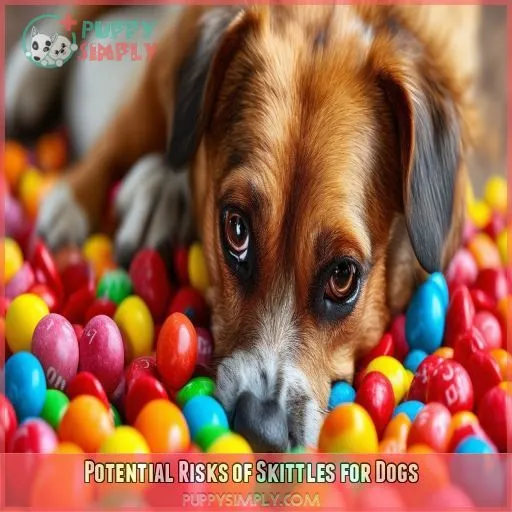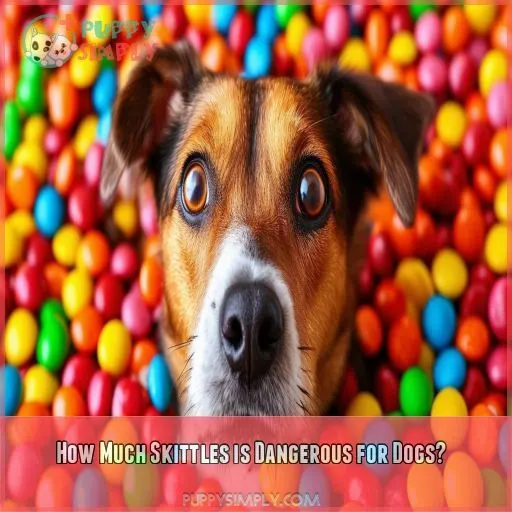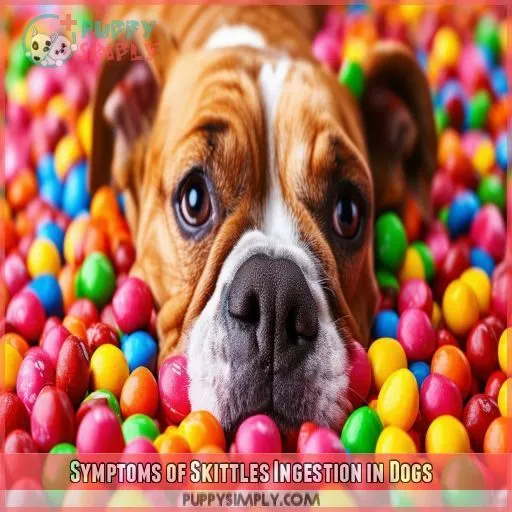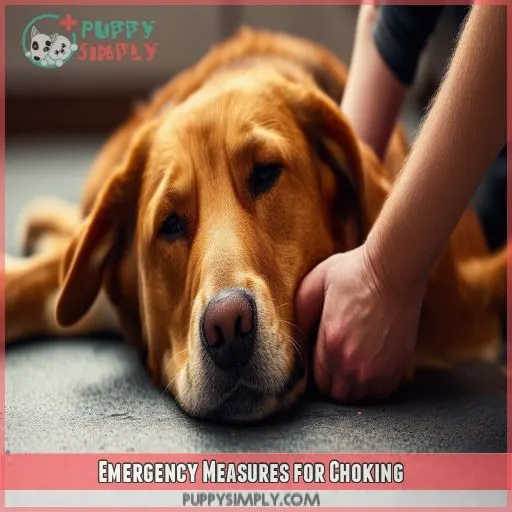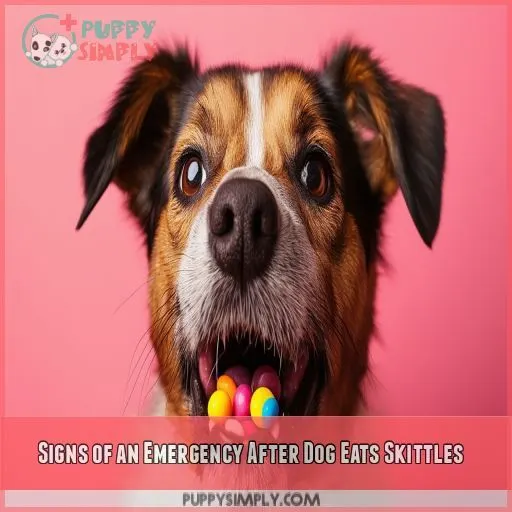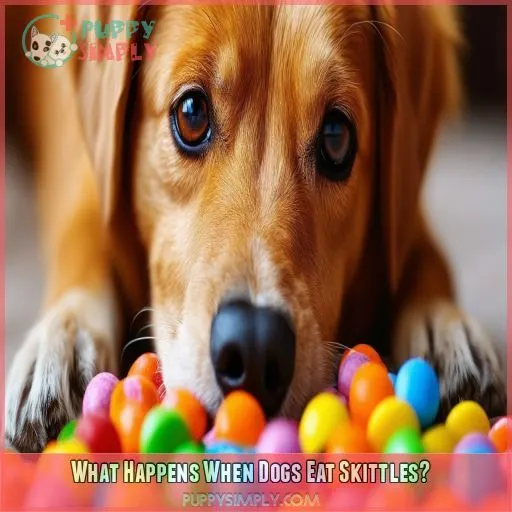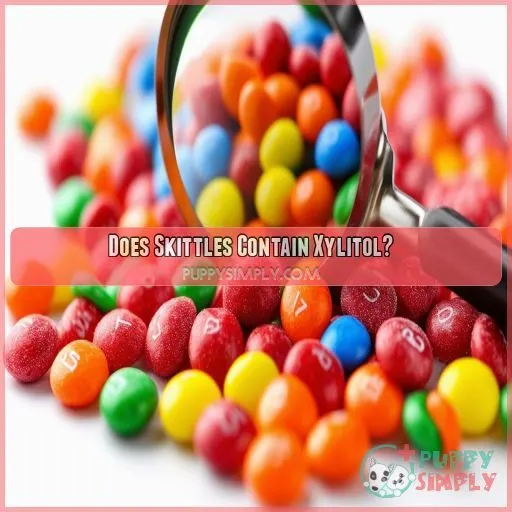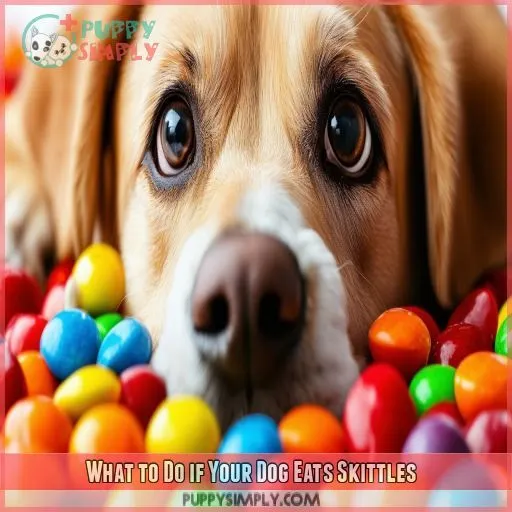This site is supported by our readers. We may earn a commission, at no cost to you, if you purchase through links.

But can dogs eat Skittles safely? While these colorful candies aren’t toxic to your furry friend, they pose surprising risks.
From potential choking hazards to digestive upset, it’s essential to understand the implications of your pup indulging in this sweet treat.
This guide will explore the dangers, symptoms to watch for, and steps to take if your dog sneaks a taste of the rainbow.
Let’s uncover the truth about dogs and Skittles.
Table Of Contents
- Key Takeaways
- Can Dogs Eat Skittles?
- Potential Risks of Skittles for Dogs
- How Much Skittles is Dangerous for Dogs?
- Symptoms of Skittles Ingestion in Dogs
- Emergency Measures for Choking
- When to Seek Veterinary Care for Skittles Ingestion
- Signs of an Emergency After Dog Eats Skittles
- What Happens When Dogs Eat Skittles?
- Does Skittles Contain Xylitol?
- What to Do if Your Dog Eats Skittles
- Frequently Asked Questions (FAQs)
- What happens if a dog eats skittles?
- Does Skittles have xylitol?
- Can dogs eat Skittles candy?
- How do you know if a dog eats skittles?
- What happens if a dog eats Skittles?
- What candy is toxic to dogs?
- Can dogs eat purple Skittles?
- Can dogs eat a little piece of candy?
- Are certain Skittles flavors more dangerous for dogs?
- Can dogs develop a taste for Skittles?
- How long does it take for Skittles to digest?
- Do different dog breeds react differently to Skittles?
- Can Skittles cause long-term behavioral changes in dogs?
- Conclusion
Key Takeaways
- While Skittles aren’t toxic to dogs, they’re about as healthy for them as a chocolate-covered broccoli stick. These rainbow treats pack a sugar punch that can lead to tummy troubles, dental disasters, and a waistline that would make even Santa blush.
- Keep those colorful candies out of Fido’s reach, unless you want to witness a reenactment of "The Exorcist" – canine edition. Choking hazards and potential blockages are no laughing matter, so it’s best to stick to treats that won’t turn your pup into a furry piñata.
- If your four-legged friend does manage to snag a taste of the rainbow, don’t panic faster than a cat in a room full of rocking chairs. Monitor them closely for any signs of distress, and remember: when in doubt, vet it out!
- Instead of Skittles, why not treat your pup to some dog-friendly snacks? After all, a carrot stick might not be as exciting as a sugar rush, but it won’t leave your pooch feeling ruff in the morning. Plus, you’ll avoid those judgmental looks from the vet during your next check-up!
Can Dogs Eat Skittles?
While Skittles might be a rainbow of joy for humans, they’re not a dog’s pot of gold.
You shouldn’t feed your furry friend these colorful candies. Sure, they’re small treats, but they’re far from ideal for your canine companion.
Instead, opt for dog-friendly candy alternatives that won’t compromise their dental health or lead to obesity concerns.
If your dog ate Skittles, don’t panic – they’re not inherently toxic to dogs.
However, they can upset your dog’s stomach. So, next time you’re enjoying these sweet morsels, keep them out of your pup’s reach.
Potential Risks of Skittles for Dogs
Skittles pose several risks to your dog’s health, including high sugar content, artificial ingredients, and potential choking hazards. These colorful candies can lead to gastrointestinal upset, obesity, and dental issues, while their small size and hard texture may cause obstruction, especially in smaller breeds.
The Sugar Factor
While Skittles aren’t toxic, they’re far from a healthy treat for your furry friend.
The sugar content in these colorful candies is a major concern.
You might think a few won’t hurt, but even small amounts can lead to dental issues and contribute to obesity.
Plus, the sudden sugar rush can cause gastrointestinal upset, leaving your pup with an uncomfortable tummy.
It’s best to stick to dog-friendly treats that won’t risk your pet’s health or waistline.
Artificial Ingredients
Beyond sugar, Skittles pack a punch with artificial ingredients.
These colorful candies contain a cocktail of food colors, flavorings, and preservatives that aren’t dog-friendly.
Your furry friend’s digestive system isn’t equipped to handle these additives, potentially leading to upset stomachs or allergic reactions.
While a single Skittle mightn’t spell disaster, regular consumption of these artificial ingredients can wreak havoc on your pup’s health.
It’s best to keep these rainbow treats out of Fido’s reach.
Choking Hazard
You mightn’t think of Skittles as a choking hazard, but for your furry friend, they can be a real threat.
These small, hard candies can easily get lodged in your dog’s throat, causing panic and potential obstruction.
Don’t forget about those sneaky wrappers, too! They’re just as dangerous, risking intestinal blockages.
To keep your pup safe, it’s best to pet-proof your space and opt for dog-friendly treats instead.
How Much Skittles is Dangerous for Dogs?
While Skittles aren’t toxic, the amount your dog consumes can make a big difference. Here’s what you need to know:
- A few stray Skittles likely won’t cause serious harm.
- A handful can lead to stomach upset and potential choking risks.
- An entire package could spell trouble, increasing the risk of severe symptoms.
The sugar content and artificial ingredients in Skittles can wreak havoc on your pup’s health. Even small amounts might trigger allergic reactions in sensitive dogs. Remember, it’s not just about the candy itself – the packaging poses a choking hazard too. Always err on the side of caution in terms of your furry friend’s well-being.
Symptoms of Skittles Ingestion in Dogs
If your dog has eaten Skittles, you’ll want to watch for signs of gastrointestinal distress, such as vomiting, diarrhea, or abdominal discomfort. You should also be alert for any choking hazard indicators, like coughing or difficulty breathing, and keep in mind that long-term health consequences from excessive sugar intake can include obesity and dental problems.
Gastrointestinal Distress Signs
After consuming Skittles, your dog may show signs of gastrointestinal distress.
Watch for stomach upset, which can manifest as vomiting or diarrhea.
You might notice your furry friend experiencing cramps or bloating, too.
These symptoms usually appear within a few hours of ingestion.
While a single Skittle mightn’t cause much trouble, a larger amount can lead to more severe discomfort.
Keep an eye on your pup and be ready to act if symptoms worsen.
Choking Hazard Indicators
While gastrointestinal issues are common, choking is a more immediate concern when dogs eat Skittles. Be vigilant for these choking symptoms:
- Excessive drooling and pawing at the mouth
- Gasping or making wheezing sounds
- Frantic pacing or restlessness
Quick action can save your pup’s life. Pet first aid and dog training are essential for choking prevention. Remember, pet safety is paramount. If you suspect your dog is choking, don’t hesitate to perform the canine Heimlich maneuver or seek emergency veterinary care.
Long-Term Health Consequences
Beyond the immediate risks, your furry friend’s Skittles habit can lead to some serious long-term health issues.
Obesity is a major concern, as those sugary snacks pack quite a caloric punch.
Diabetes might also rear its ugly head, wreaking havoc on your pup’s metabolism.
Don’t forget about those pearly whites – dental problems are a real threat.
Finally, hormonal disturbances could throw your dog’s entire system out of whack.
It’s clear that Skittles are no treat for your four-legged companion.
Emergency Measures for Choking
If your dog’s choking on Skittles, don’t panic!
First, check their mouth for any visible obstructions. If you can’t remove it safely, it’s time for the Heimlich maneuver.
Position your hands over your pup’s stomach, just behind the ribcage. Apply five quick, forward-and-upward thrusts.
This first aid technique can be a real lifesaver!
After dislodging the candy, sweep your dog’s mouth to remove any remaining pieces.
Dog-proofing your home and keeping treats out of reach can prevent these scary situations.
Stay vigilant, and keep your furry friend safe!
When to Seek Veterinary Care for Skittles Ingestion
When to seek veterinary care for your pup’s Skittles adventure? While a few candies might only cause mild gastric upset, certain situations warrant immediate attention. Don’t hesitate to call your vet if:
- Your dog’s tummy troubles persist beyond 1-2 days
- You notice severe vomiting or diarrhea
- Your furry friend becomes lethargic or stops eating
- There’s suspicion of xylitol toxicity (in sugar-free varieties)
Signs of an Emergency After Dog Eats Skittles
While most cases of dogs eating Skittles aren’t severe, there are signs that indicate a medical emergency. Watch for symptoms of choking, bloat, or intestinal obstruction, which can be life-threatening and require immediate veterinary attention.
Choking
If your dog’s eaten Skittles, choking is a serious concern. Watch for these signs of airway obstruction:
| Symptom | Action |
|---|---|
| Excessive drooling | Check mouth |
| Pawing at face | Clear obstruction |
| Gagging or coughing | Perform Heimlich |
| Blue tongue or gums | Seek vet immediately |
For choking prevention, stick to safe treats for dogs. If you suspect your furry friend’s choking, act fast! The Heimlich maneuver technique could save their life. Remember, dog first aid knowledge is priceless in these hairy situations.
Bloat
If your dog’s eaten Skittles, watch out for bloat.
This serious condition can be life-threatening. You’ll notice your pup retching without producing anything, or maybe some white foam. They might seem restless and their belly could look swollen.
Bloat causes can include overeating or swallowing air while gobbling treats.
Quick treatment is essential, so don’t hesitate to call your vet.
Bloat prevention starts with portion control and slowing down meal times.
Obstruction
If your dog’s eaten Skittles, watch out for obstruction symptoms. These can be serious and require immediate vet attention. You’ll notice:
- Diarrhea followed by constipation
- Abdominal pain or swelling
- Loss of appetite and lethargy
Prevention’s key – keep those colorful candies out of reach! If obstruction occurs, treatment often involves surgery. The prognosis depends on early detection and intervention. Recovery can take weeks, but with proper care, most dogs bounce back. Remember, it’s better to be safe than sorry!
What Happens When Dogs Eat Skittles?
When your dog eats Skittles, you’ll want to keep a close eye on them. The candy’s ingredients can wreak havoc on your pup’s system, leading to a rollercoaster of reactions. Here’s a quick breakdown of what might happen:
| Time Frame | Symptoms | Action |
|---|---|---|
| Short-term | Vomiting, diarrhea | Monitor closely |
| Medium-term | Hyperactivity, lethargy | Provide water |
| Long-term | Weight gain, dental issues | Consult vet |
While a few Skittles mightn’t spell disaster, it’s best to steer clear of these rainbow treats. Remember, your furry friend’s health is no laughing matter. Opt for safer, dog-friendly alternatives to keep tails wagging and tummies happy.
Does Skittles Contain Xylitol?
Now that you know what happens when dogs eat Skittles, you might be wondering about a specific ingredient: xylitol.
Here’s the scoop: regular Skittles don’t contain xylitol, a sugar alternative that’s toxic to dogs.
However, it’s essential to be aware of xylitol poisoning when considering canine treats.
While Skittles aren’t a healthy choice for pet nutrition, they don’t pose the same immediate danger as xylitol-containing products.
Still, it’s best to stick to dog-specific treats to support your furry friend’s digestive health.
What to Do if Your Dog Eats Skittles
If your dog eats Skittles, don’t panic. Take action to guarantee your furry friend’s safety:
- Remove any remaining candy from reach
- Check for signs of choking or distress
- Monitor for symptoms like vomiting or diarrhea
- Provide fresh water and a bland diet
Home care is essential. Keep a close eye on your pup, watching for any unusual behavior. If symptoms persist or worsen, call your Vet immediately. To prevent future incidents, focus on pet-proofing your space. Store sweets securely and offer dog-friendly alternatives like carrot sticks or apple slices. Remember, a Skittle-free home is a happy, healthy home for your four-legged companion.
Frequently Asked Questions (FAQs)
What happens if a dog eats skittles?
If your dog eats Skittles, they might experience stomach upset, vomiting, or diarrhea. While not toxic, the high sugar content can cause discomfort. Monitor your pup closely and contact your vet if symptoms persist or worsen.
Does Skittles have xylitol?
Ever wondered about the hidden dangers in your candy? You’ll be relieved to know that regular Skittles don’t contain xylitol. However, it’s essential to check the ingredients, as some sugar-free versions might include this potentially harmful sweetener for dogs.
Can dogs eat Skittles candy?
You shouldn’t feed your dog Skittles. They’re not toxic, but the high sugar content can upset their stomach and lead to health issues. Keep these colorful treats for yourself and offer your pup dog-friendly snacks instead.
How do you know if a dog eats skittles?
You’ll spot a Skittles-eating pup faster than a rainbow appears! Look for colorful drool, unusual behavior, or digestive issues. Check their surroundings for empty wrappers or scattered candies. Monitor for vomiting, diarrhea, or lethargy.
What happens if a dog eats Skittles?
If your dog eats Skittles, they might experience stomach upset, vomiting, or diarrhea. While not toxic, the high sugar content can lead to obesity and dental issues. Monitor your pup closely and contact your vet if symptoms persist.
What candy is toxic to dogs?
Like a forbidden fruit in a canine Eden, chocolate reigns as the most toxic candy for dogs. You’ll want to keep your furry friend away from xylitol, macadamia nuts, and raisins too. They’re all potential poison for pups.
Can dogs eat purple Skittles?
You shouldn’t feed your dog purple Skittles. They’re not toxic, but they’re packed with sugar and artificial ingredients that can upset your pup’s tummy. Stick to dog-friendly treats instead for a happier, healthier pooch.
Can dogs eat a little piece of candy?
A spoonful of sugar may sweeten life, but it’s not for Fido. While a tiny piece of candy won’t likely harm your dog, it’s best to avoid giving them any. Stick to dog-friendly treats instead.
Are certain Skittles flavors more dangerous for dogs?
No Skittles flavors are safe for dogs. While none are particularly toxic, all contain high sugar and artificial ingredients that can upset your pup’s stomach. It’s best to avoid giving any Skittles to your furry friend.
Can dogs develop a taste for Skittles?
Yes, dogs can develop a taste for Skittles. Their sweet tooth might lead them to crave these sugary treats. However, it’s imperative you don’t indulge this preference, as Skittles aren’t healthy for your furry friend’s diet.
How long does it take for Skittles to digest?
Skittles typically take 2-4 hours to digest in humans. For dogs, it’s similar, but can vary based on size and metabolism. You’ll want to monitor your pup closely during this time for any adverse reactions.
Do different dog breeds react differently to Skittles?
While Chihuahuas might shake at the sight, Great Danes won’t bat an eye. You’ll find that different breeds can react uniquely to Skittles. Size, metabolism, and individual sensitivities play a role in how dogs respond to these colorful treats.
Can Skittles cause long-term behavioral changes in dogs?
While Skittles don’t directly cause long-term behavioral changes, frequent consumption can lead to health issues that might affect your dog’s behavior. Obesity, dental problems, and diabetes from excessive sugar intake can impact your pup’s mood and energy levels.
Conclusion
While Skittles may be a rainbow-flavored delight for humans, they’re a minefield of potential issues for your furry friend.
Can dogs eat Skittles? Technically, yes, but it’s not advisable.
The risks—from choking hazards to digestive upset—far outweigh any fleeting enjoyment.
If your dog does sneak a taste, watch for symptoms and know when to seek veterinary care.
Your best bet? Keep those colorful candies out of paw’s reach and opt for dog-friendly treats instead.
Your pup’s health is worth more than a sugary indulgence.

